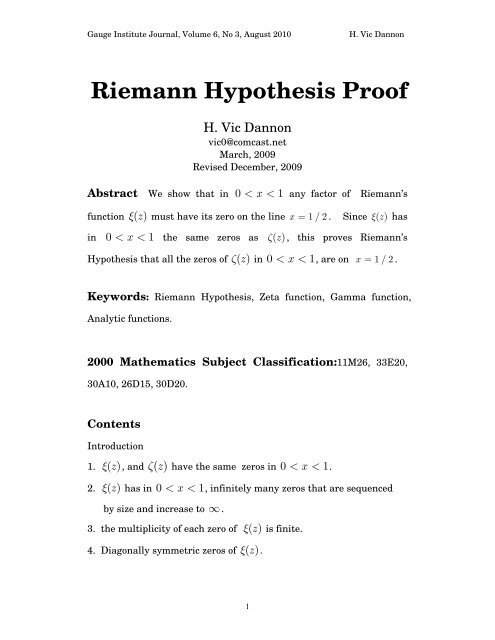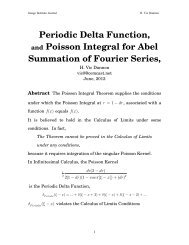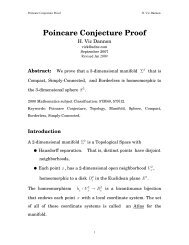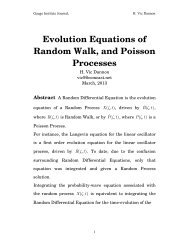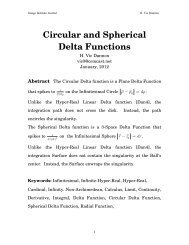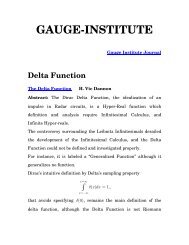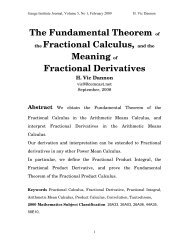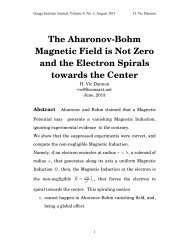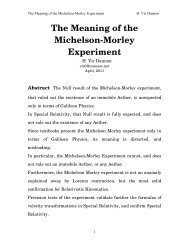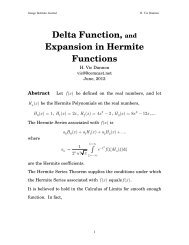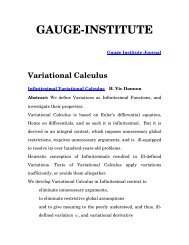Riemann Hypothesis Proof - Gauge-institute.org
Riemann Hypothesis Proof - Gauge-institute.org
Riemann Hypothesis Proof - Gauge-institute.org
You also want an ePaper? Increase the reach of your titles
YUMPU automatically turns print PDFs into web optimized ePapers that Google loves.
<strong>Gauge</strong> Institute Journal, Volume 6, No 3, August 2010H. Vic Dannon<strong>Riemann</strong> <strong>Hypothesis</strong> <strong>Proof</strong>H. Vic Dannonvic0@comcast.netMarch, 2009Revised December, 2009Abstract We show that in 0 < x < 1 any factor of <strong>Riemann</strong>’sfunction ξ()z must have its zero on the line x = 1/2. Since ξ()z has0 < x < 1()in the same zeros as ζ z , this proves <strong>Riemann</strong>’sζ()z< x < 11/2<strong>Hypothesis</strong> that all the zeros of in 0 , are on x = .Keywords: <strong>Riemann</strong> <strong>Hypothesis</strong>, Zeta function, Gamma function,Analytic functions.2000 Mathematics Subject Classification:11M26, 33E20,30A10, 26D15, 30D20.ContentsIntroductionξ () z ζ()z1. , and have the same zeros in 0 1.ξ()z< x < 1< x
<strong>Gauge</strong> Institute Journal, Volume 6, No 3, August 2010H. Vic Dannon5. Observing ξ( x − iy) = ξ(x + iy) , for 0 < x < 1.6. A convergent infinite product is zero if and only if at least one of its factorsis zero.7. Absolutely Convergent Infinite Product.8. The Weierstrass Factorization of ξ()z9. The Hadamard factorization of ξ()z10.x = , for any zero .nDiscussion12z nAPPENDIX: <strong>Proof</strong> of Hadamard Factorization 9.1AcknowledgementsReferences2
<strong>Gauge</strong> Institute Journal, Volume 6, No 3, August 2010H. Vic DannonIntroductionIn his 1859 Zeta paper, <strong>Riemann</strong> obtained a formula for the count ofthe primes up to a given number. <strong>Riemann</strong>’s formula has four terms.But only the first and the third terms have non-negligible values. Thefirst is the dominant term, and can be computed precisely. The third issmaller and depends on the provision that all the zeros of the Zeta0 < x
<strong>Gauge</strong> Institute Journal, Volume 6, No 3, August 2010H. Vic DannonBut expecting massive endless computations to disprove the <strong>Riemann</strong><strong>Hypothesis</strong> by finding a zero off the linex = 1/2, is statisticallyimplausible.In fact, statistical tests indicate that the <strong>Riemann</strong> <strong>Hypothesis</strong> holdswith extremely high statistical certainty. In 2008, we applied a Chi-Squared Goodness-of-Fit-Test to the <strong>Riemann</strong> formula for the count ofthe primes, and confirmed that the <strong>Riemann</strong> <strong>Hypothesis</strong> holds withcertainty that is limited only by the software [Dan2].In sections 1 to 4, we present <strong>Riemann</strong>’s functionξ()z, and known factsabout its zeros. In section 5, we recall that ξ( x − iy) = ξ(x + iy).This fact serves as a key result for the proof.In 8.2, we present a key result that follows from the Weierstrassfactorization ofξ()z, and in 9.1 a key result due to Hadamard.The last key result due to Titchmarsh, is presented in section 10.0 < x < 1ξ()zThere, we prove that in , any factor of must have itszero on the line x = 1/2.< x < 1ζ()zSince ξ()z has in 0 the same zeros as , this proves that allζ()z< x < 1 x = 1/2the zeros of in 0 , are on .ξ () z ()1. , and ζ z have the same zeros in 0 < x < 1For x + i y = z ∈ , <strong>Riemann</strong> gave the Definition11() z Γ( z)()ζ z2z 22π1.1 ξ ≡1zz ( − 1)1Γ()z0 < x < 1PropositionSince has no zeros in , [Saks], we have the4
<strong>Gauge</strong> Institute Journal, Volume 6, No 3, August 2010H. Vic Dannon1.2 () z0 < x
<strong>Gauge</strong> Institute Journal, Volume 6, No 3, August 2010H. Vic DannonFor ζ () z , <strong>Riemann</strong> derived the functional equation ξ() z = ξ(1 −z).Therefore, we have the Proposition4.1 If zn= xn+ iy is a zero of ξ()z , then so is 1− z 1 iy .n n= −xn− nThese two zeros are diagonally symmetric with respect to z =1,2because denoting x =1+ α n, we have − x =1− α .n21n 2 n5. Observing ξ( x − iy) = ξ(x + iy) , for 0 < x < 1,<strong>Proof</strong>: <strong>Riemann</strong> obtained an integral formula for ξ()z ,t =∞t = 1−( 1 ( z+ 1) 1 z−12 2)ξ( z) =1+ zz ( − 1) ψ(t)t + t d2 ∫ t,1 1 1ψ( t) ≡ + + + .....,πt e2 πt 3 πte ewhere the infinite series2 2converges uniformly for12t ≥ 1. Therefore,t =∞t = 1−( 1 ( z + 1) 1 z−12 2)ξ( z) = + z( z − 1) ψ( t)t + t12∫t =∞∫t = 1−( 1 ( z+ 1) 1 z−12 2)= + zz ( − 1) ψ( t)t + t dtdtThat is, we have= ξ() z = ξ()z .ξ( x − iy) = ξ( x + iy).6
<strong>Gauge</strong> Institute Journal, Volume 6, No 3, August 2010H. Vic Dannon6. A convergent infinite product is zero if and only ifat least one of its factors is zeroAnalytic functions are effectively represented as infinite products[Saks, VII].By the definition in [Saks, p. 286],The Infinite Product aaa 1 2 3 ... converges to if and only if there is ann 0index , so that all the terms after it are non-zero, andConsequently,0 0 0pa , a , a ,...n + 1 n + 2 n + 30 0 0an + 1an + 2 ... an + m→ q ≠ 0 .p = aa1 2 ... an q.0Therefore, [Saks, p. 287], has the Proposition6.1 The value of a convergent infinite product is equal to zero if andonly if at least one of its factors is zero.The product of a = 1 − 1that has no such q , diverges to zero,nnalthough it satisfies the convergence necessary conditionp. 287].an→ 1[Saks,If a convergent infinite product equals zero, this is due to only finitelymany vanishing factors, without which, the remaining infinite productis non-zero.7
<strong>Gauge</strong> Institute Journal, Volume 6, No 3, August 2010H. Vic Dannon7. Absolutely Convergent Infinite ProductWe’ll need Absolute Convergence, so that the infinite products willconverge independently of the order of their factors.By the definition in [Saks, p. 288],(1 )(1 )...+ u1 + u2converges absolutely ⇔ u1 u2(1 + )(1 + )... converges.Since(1 + u1)(1 + u2)...converges if and only if u1 + u2 + ... converges,we have in [Saks, p. 289] the Proposition+ + u1 + u2 + ... converges.7.1 (1 u )(1 u )... converges absolutely ⇔1 2Consequently, since the value of an absolutely convergence series doesnot depend on the order of the summation, we have Proposition7.2 The value of an absolutely convergent infinite product does notdepend on the order of its factors.8. The Weierstrass Factorization of ξ()zξ 0 < x < 1By 2.2, the zeros of () z in ,z1, z2, z3,...,are sequenced by size, and increase to ∞ .z1 ≤ z2 ≤ z3 ≤ ... ↑ ∞.Sinceξ()zis an analytic function in the complex plane so thatξ(0) ≠ 0 ,8
<strong>Gauge</strong> Institute Journal, Volume 6, No 3, August 2010H. Vic Dannonz' sand since the are sequenced by their size and increase to ∞ ,nThen, by Weierstrass [Saks,VII, 2.13], we havewherethe polynomials∞hz ( ) z Q ( )( ) n z∏ e ,n=1znξ() z = e 1−Qn () zthe product in the open plane, andhz ()is analytic in the complex plane.guarantee the uniform convergence ofThe zeros 1 − z nof 4.1 appear in the factorization, and we haveProposition8.1∞hz ( ) z z Q ( )( )( )11n z∏ .n=zn znξ() z = e 1 − 1 − e −While the 1 − z n’s appear in the factorization,1 2 3We stress this crucial point with Proposition8.2z , z , z ..... DO NOT.z1, z2, z3....do not appear in the Weierstrassξ()zFactorization of .<strong>Proof</strong>: The appearance of the zero z 1of 5, will require the inclusion ofthe factorz1 − , that vanishes whenever z = z1.z19
<strong>Gauge</strong> Institute Journal, Volume 6, No 3, August 2010H. Vic DannonIt is well known that the functiongz ()is not differentiable with respect to z .= z,Therefore, the factorz1 − is not differentiable with respect to z .z1Consequently, multiplying byz1 − will produce a function that isz1not differentiable with respect to z .In particular, including any of the factorsin the factorization will makez z z1 − , 1 − , 1 −z z z1ξ()z23,…not differentiable.But sinceξ()zis an analytic function in the complex plane, it isdifferentiable of any order, at any point z in the complex plane.A similar argument prevents the appearance of any of the factorsz z z1 − , 1 − , 1 − ,….1 − z 1 − z 1 − z1239. The Hadamard factorization of ξ()zHadamard showed that forandξ()z, we haveQ ( z)en= 1,hz ( )e = .Thus, simplifying the Weierstrass product representation of .12ξ()z10
<strong>Gauge</strong> Institute Journal, Volume 6, No 3, August 2010H. Vic Dannonξ()zHadamard factorization for is the 3rdkey result for the<strong>Hypothesis</strong> proof. This is Proposition9.1z z z zξ() z⎛ 1 ⎞ ⎛ ⎞ ⎛⎜1 ⎟⎛ 1 ⎞⎞= ⎜ − ⎟ − ⎜ − ⎟⎜1− ...⎟⎠12z11 z⎜⎜⎝ ⎟1⎠ z⎝ ⎠⎟− ⎝ ⎜ ⎟⎜2⎠⎝1−z2,where the product converges absolutely, and uniformly with respect tothezs ', its value does not depend on the order of its factors, and itvanishes only at the zeros of ξ()z .z ,1 −z , z ,1 −z , z ,1 −z,.... do not appear inThe conjugate roots, 1 1 2 2 3 3ξ()zthe factorization of .A proof of this established result, is in the Appendix. We note that thez ’s do not appear in the factorization of , by 8.2,nξ()z10.x = , for any zeron12z n<strong>Proof</strong>: To keep it readable, we’ll take , and assume that z hasmultiplicity 2. Say, z z , andSince z = x + iy is a zero of ξ ,7 777n = 77z < z = z < z 9= 8 6 7 8By 5,Thus,ξ ( x + iy ) = 0.7 7ξ( x − iy ) = 0.7 7ξ( x − iy ) = 0.7 7Applying 9.1 to ξ( x − iy ),7 711
<strong>Gauge</strong> Institute Journal, Volume 6, No 3, August 2010H. Vic Dannon⎛ x7 iy ⎞⎛7x7 iy ⎞⎛7x7 iy ⎞⎛7x7 iy ⎞70 −1 −1 −1 −= 1− − − −⎜ z⎟⎜ 1−z⎟ ⎜ z⎟ ⎜ 1−z⎝ ⎠⎝ ⎠⎝ ⎠⎝ ⎟⎠ ...Since we assumed1 1 2 2z7= z8, we have⎛ x7 iy ⎞⎛7x7 iy ⎞ ⎛7x7 iy ⎞⎛7x7 iy ⎞70 −1 −1 ... −1 −= 1− − − − ×⎜ z⎟ ⎜ 1−z⎟ ⎜ z⎟ ⎜ 1−z⎝ ⎠⎝ ⎠ ⎝ ⎠⎝ ⎠⎟1 1 6 62 27−7 7−7 7−7 7−7⎛ x iy ⎞ ⎛ x iy ⎞ ⎛ x iy ⎞⎛ x iy ⎞× 1− 1 1 1 ⎟...z− − −1 zz⎝ ⎜ ⎠⎟ ⎜⎝ − ⎠⎟ ⎝ ⎜ ⎠⎝ ⎟⎜ 1−z⎠⎟7 7 99m ≠ 7, 8z ≠ z7Clearly, for , the factors with are all non-zero.mIndeed,x7− iy71− = 0 ⇒ zzAnd,mm= z , contradicting 8.2.71 x7 − iy7− =7 710 ⇒ 1 − z m = x −iy⇒ z− zmm= 1−z7, contradicting 8.2.Since all the factors withThus,Hence,zm≠ zx7−iy7 x7−iy7( 1 ) ( 1 )z77 7are non-zero, by 6.1, we must have2 2− − 01 11−z= .2 2x −iy x −iy= .7 7 7 7− − 0z7 1−z72 24 y7 1−2x72 27+71 −7−7x iy x iy= 0 .That is,224y1−2x772 2 2 27+7(1 −7)+7x y x y=012
<strong>Gauge</strong> Institute Journal, Volume 6, No 3, August 2010H. Vic DannonNow, the three terms that include2y 7are non-vanishing.To see that, note the 4 th key result for the <strong>Hypothesis</strong> <strong>Proof</strong>, due toTitchmarsh, [Titch, p.329-332],0 < x < 1 0 ≤ y ≤ y1ζ()zin , and , has only one zero on the linex = 1/2114.134725132, at y =,Thus,y 7must be out of the Titchmarsh rectangle.That is, y y , and any one of the terms with is greater than72≥ 1y 72y1> 196 .Therefore, we haveThat is,1− 2x= 0.7x17= .2Replacing 7 with n , and 2 with k , we conclude that ifz nis a zero ofmultiplicityk , then we’ll apply the arguments above to obtain thatx = .n12DiscussionThe proof ties together key results due to <strong>Riemann</strong>, Weierstrass,Hadamard, and Titchmarsh.Each of these results is crucial to the proof:Hadamard Factorization, 9.1, lists all the zeros of zeta, and enables usto deal with them all.<strong>Riemann</strong>’s result, 5, applied to Hadamard’s factorization yields aninfinite product with mainly non-zero factors.13
<strong>Gauge</strong> Institute Journal, Volume 6, No 3, August 2010H. Vic DannonWeierstrass result 8.2, enables us to toss away the non-zero factors,and focus on the few that vanish.Titchmarsh result in 10, allows us to eliminate the rest of the non-zeroterms, and conclude that all the zeros are on the line x =1.2The crucial role of these components of the proof, suggests that thismay be the only path to a comprehensible, direct proof.14
<strong>Gauge</strong> Institute Journal, Volume 6, No 3, August 2010H. Vic DannonAPPENDIX: <strong>Proof</strong> of Hadamard Factorization 9.1A.Q ( z)en= 1Q ( z)To establish en= 1, we aim to show that for all z in 0 < x < 1,∞⎛ z ⎞⎛ z ⎞ ⎛ (1 )1 z1 − z− − = 1−⎝⎜ z ⎠⎝ ⎟⎜ 1 −z⎠ ⎟ ⎝⎜z ( −z∏ ∏ 1 )n=1 n n n n n⎞⎟⎠convergesabsolutely.By 7.1, we need to show that∑ 1z (1 − z )converges.m m m2( 2n−1)For instance, cos( πz) = 1 −2z( )because∞1∑ converges.2(2n−1)n=1Note that,∞∏ converges absolutely,n=121 2 1m(1 zm) ( zm)2 4z − = − −21 2iy12 m 4= ( x − + ) −m21 2 21m 2 m m 2 m= ( x − ) − y + 2 i( x − ) y − 1 42( ) 21 2 2 1 1 2m 2 m 4 m 22= ( x − ) −y − + 4( x − ) y1 4 4 1 1 1 2 1 2 1 2m 2 m 16 2 m 2 2 m m 22= ( x − ) + y + − ( x − ) + y + 2( x − ) y( ) 21 2 2 1 1 1 2m 2 m 16 2 m 2= ( x − ) + y + − ( x − ) + y 2m1 2 mm15
<strong>Gauge</strong> Institute Journal, Volume 6, No 3, August 2010H. Vic Dannon41 1 1 1 2 1 2= zm− + − ( x )2 16 2 m− + y2 2 mNow,1 1 1 2 1 2( x16 2 m) y2 2 m− − + > 0, because x 1m− ≤ 1 2 2 , and by aresult of Titchmarsh (that we state in section 10), ym≥ y1 > 14 .Therefore,Hence,212z (1 − z ) > z − .zm m mm1 1 1 so thatlogR m> 1,m = 4 R log R .mmlogmlogRm> .Hadamard showed [Dan3, 10.3], that the number of zeros ofz − ≤ R is bounded by 2 R l ogR.12 mmmξ()zin16
<strong>Gauge</strong> Institute Journal, Volume 6, No 3, August 2010H. Vic DannonSince we tookm 4R logR=m m, we haveTherefore,zm− > R .121 1≤∑ ∑2 2m> N z1 m N Rm− > m2m( logmSince )21/2mandTherefore,and1= 4 ∑ (log m)2 2R2m>N m2≤ 4 ∑m>N( logm) 2m2( logm) 22 1= 4 ∑ .3/2 1/2m mm>N→ 0 , as m →∞, we have( logm) 2m1/2m> N z m−∞⎛ z ⎞⎛z1 ∏ −1−⎜⎝ z ⎠⎝⎟⎜1 − z< 1, for m > N ,1∑
<strong>Gauge</strong> Institute Journal, Volume 6, No 3, August 2010H. Vic Dannon∞hz ( ) z zξ() z = e ∏ ( 1 − )( 1z− ),1 − zn=1 n nwhere the infinite product converges absolutely, and uniformly withrespect to the zs ' .B. The order of an entire functionBy [Holl, p. 68], the Hadamard Factorization Theorem applies to anentire function f () z for which1lim sup log log max ( )logRfzR→∞ z = R≡ < ∞. is called the order of f () z .For instance, if f () z cos( πz)= ,cos( πz)= e + e12iπz−iπz1 ( iπz−iπze e )21 iπ( x+ iy) − iπ( x+iy)2( e e )1 ( −πyπye e )≤ += += +2≤ e πyThus,ze π≤ .1 1log log max cos( πz) ≤ log log maxlog R z = R logRz = Rze π18
<strong>Gauge</strong> Institute Journal, Volume 6, No 3, August 2010H. Vic Dannon==1log loglogR1log( πR)logRRe πHence, f () z = cos( πz ) has order = 1.1= (log π + log R )logRlog π= 1 +logRR →∞→ 1, as .hz ( )C. e =1.2hz ( )ξ()z1Hadamard showed that for , e = .Hadamard replaced Weierstrass entire functionwith a polynomialso thathz (),Qz (),2deg Qz ( ) ≤ .It is well-known ([Ed] or [Dan3, 10.2]), that if R is large enough,log ξ( z) ≤ RlogR in z −1≤ 2R. Hence,1221 1log log max ξ( z) ≤ log loglogRz − = R logR( R R )log logR= 1 + .logR19
<strong>Gauge</strong> Institute Journal, Volume 6, No 3, August 2010H. Vic DannonSince by L'Hospitalwe concludelimR→∞log logRlogR1 1log RRlimR→∞1R= = 0 ,1lim sup log log max ξ( z) = 1.logRz−= RR→∞12That is,Hence,That isξ () z is of order = 1.deg Qz ( ) ≤ 1.Qz () = A+ Bz ( − ),12for some constants A , and B .Since the factorization factors are1 2−12 41 2 12 4z z z(1 − z)( z − )1−1−= 1−= 1−,z 1 −zz (1 −z) ( z − ) −( )( )we have,n n n n n⎛⎞ ξ() z = e1 − ,⎠⎟where the product is an even function ofBut <strong>Riemann</strong> showed [Dan3, 9.2] that01 2 1A+ B( z−1) ( z − ) −22 4∏1 2( )1n ⎜⎝zn− −2 41z − .21 21 41( z ) A2 2( )2ξ( z) = A + A − + z − + ....is an even function of ( z −1).2Consequently,andB = 0 ,20
<strong>Gauge</strong> Institute Journal, Volume 6, No 3, August 2010H. Vic DannonSetting z = 0 ,⎛ ( z ) ⎞A− −ξ() z = e1− ⎜n ( z )⎜⎝ − − ⎠⎟Aen1 221 221414∏ .ξ(0)= .By <strong>Riemann</strong>’s Integral formula for ξ()z , that we used in 5,Hence, we haveTherefore,t =∞t = 1−( 1 ( z+ 1) 1 z−12 2)ξ( z) =1+ zz ( − 1) ψ(t)t + t d2 ∫ t.ξ (0) = .1⎛ ( z ) ⎞ − −ξ() z = 1− ⎜ ( z )⎜⎝ − − ⎠⎟122 n n1 221 221414∏ .1 ⎛ z ⎞⎛ z= 1 ∏ − 1−2 ⎜⎝ z ⎠⎝⎟⎜1−zn n nwhere the infinite product converges absolutely, and uniformly withrespect to the zs ' .⎞⎠⎟21
<strong>Gauge</strong> Institute Journal, Volume 6, No 3, August 2010H. Vic DannonAcknowledgementsThis proof owes its existence to the serious critique of many since 2005.I am most obliged to them.I thank the Canadian Number Theory Association IX Meetingparticipants who let me present my attempts on July 2006, inVancouver, British Columbia.I am very grateful to the Pacific Coast Number Theory Conferenceparticipants who let me present my attempts on December 2008, inFort Collins, Colorado,and let me present a preliminary version of this proof on December2009 in Asilomar, California.22
<strong>Gauge</strong> Institute Journal, Volume 6, No 3, August 2010H. Vic DannonReferences[Dan1] Dannon, Vic, <strong>Riemann</strong>’s Zeta paper: The Product Formula Error,<strong>Gauge</strong> Institute Journal of Math and Physics, May 2006.[Dan2] Dannon, Vic, Chi-Squared Goodness-of-Fit-Test of the <strong>Riemann</strong><strong>Hypothesis</strong>, <strong>Gauge</strong> Institute Journal of Math and Physics, August 2008.[Dan3] Dannon, Vic, <strong>Riemann</strong>’s Zeta Function: the <strong>Riemann</strong> <strong>Hypothesis</strong>Origin, the Factorization Error, and the Count of the Primes, <strong>Gauge</strong> InstituteJournal of Math and Physics, November 2009.[Ed]. Edwards, H. M. <strong>Riemann</strong>’s Zeta Function, Academic Press, 1974.[Hada] Hadamard, J., “Etude sur les Proprietes des fonctions Entieres et enparticulier d'une fonction consideree par <strong>Riemann</strong>” J. Math. Pures Appl. [4] 9,1893, pp. 171-215. Also, in [Ed, chapter 2][Hasel] Haselgrove C. B. and Miller J.C.P., Tables of the <strong>Riemann</strong> ZetaFunction, Cambridge University Press 1960.[Holl] Holland, A. S. B., “Introduction to the Theory of Entire Functions”,Academic Press, 1973.[Riem]. <strong>Riemann</strong>, B., “On the Number of Prime Numbers less than a givenquantity”, 1859, in God Created the Integers: The MathematicalBreakthroughs that changed History, edited by Stephen Hawking, RunningPress, 2005. Page 876.<strong>Riemann</strong>’s paper was translated also by H. M. Edwards, in Appendix to [Ed].And by Roger Baker, Charles Christenson, and Henry Orde, In “CollectedPapers, Bernhard <strong>Riemann</strong>”, Kendrick Press, 2004.[Saks]. S. Saks, and A. Zygmund, Analytic Functions. Second Edition, PolishScientific Publishers, 1965.[Titch]. Titchmarsh, E. C., The Theory of the <strong>Riemann</strong> Zeta Function. OxfordU. Press, 1951.23


